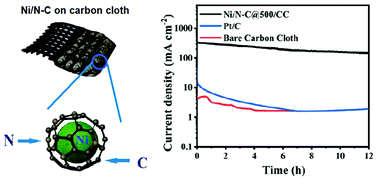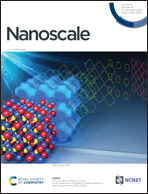Nickel nanocrystal/nitrogen-doped carbon composites as efficient and carbon monoxide-resistant electrocatalysts for methanol oxidation reactions†
Abstract
High-performance electrocatalysts for the methanol oxidation reaction (MOR) are the key to advance the application of direct methanol fuel cells. Pt-Based electrocatalysts for the MOR are limited due to their high cost, low stability and poor resistance to carbon monoxide (CO) poisoning. The development of non-noble metal-based electrocatalysts for the MOR with high activity and good stability is desired, but it remains a challenge. Herein, we report a simple strategy to prepare nickel nanocrystals embedded in a nitrogen-doped carbon matrix (Ni/N–C composite) by pyrolysis of Ni-coordinated polyaniline–poly(vinyl alcohol) hydrogels. These in situ generated Ni nanocrystals serve as active electrocatalysts for the MOR, while the nitrogen-doped carbon matrix serves as a conductive support to facilitate electron transfer and also to protect the active Ni nanocrystals. The optimal Ni/N–C@500 electrocatalyst shows a high MOR activity of 147 mA cm−2 at 1.66 V vs. the RHE in alkaline methanol solution, which is outstanding among Ni-based MOR electrocatalysts. Ni/N–C@500 also shows better stability than the Pt/C catalyst in the long-term MOR test at high current densities. Upon CO poisoning, Ni/N–C@500 retains 85% of its MOR activity, far exceeding the performance of the Pt/C catalyst (61% retention). Owing to its facile synthesis, outstanding activity and high stability, the Ni/N–C@500 composite is promising as a low-cost, efficient and CO-resistant electrocatalyst for the MOR.



 Please wait while we load your content...
Please wait while we load your content...